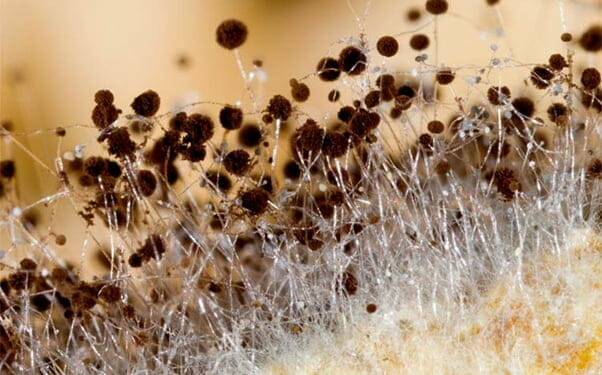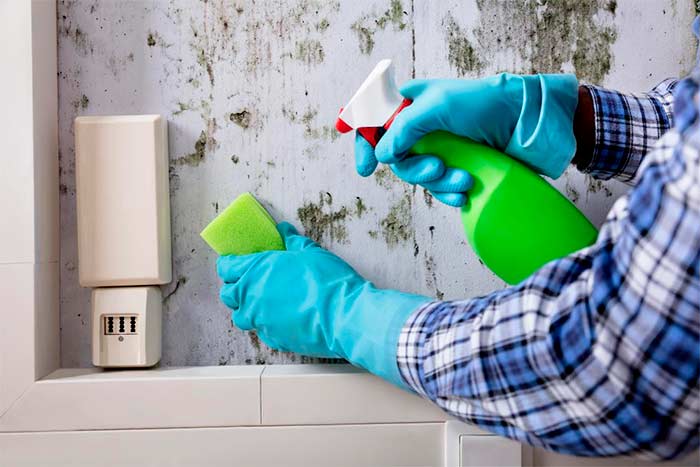Discerning mold from dust can be a challenging task, especially for individuals who are not familiar with mold growth. The appearance of mold and dust can significantly vary, including differences in size, shape, and color, and they often appear on many surfaces within your home. Identifying one from the other by sight alone can be difficult.
Mold is a living organism that will grow when exposed to water and a food source, whereas dust is simply made up of static organic and inorganic particles. There are a few key ways to tell the difference between dust and mold.
Once you have diagnosed mold growth in your home using our helpful guide, it’s important that you seek the advice of a mold professional. They will be able to help remedy your mold problem by inspecting and remediating any growths that you may have in your home or property.
What we cover
ToggleWhat is Mold? What is Dust?

Mold is a type of fungus. It can grow almost anywhere and reproduces by means of tiny spores. It requires moisture in order to grow, and its spores spread through the air, on clothing and hair, or even on dust particles!
Dust, commonly thought to just be made up of dead skin cells, is actually composed of many, many things. As well as the aforementioned dead skin cells, dust is also made up of hair, pollen, bacteria, dead insects, and even minute traces of plastic!
Visual differences to distinguish dust from mold
It probably comes as no surprise that mold will appear differently depending on which type of mold is growing in your home or property.
Some molds, such as Penicillium and Fusarium will be easy to distinguish from mold because of their distinctive colors, while other common molds such as Cladosporium, aspergillus, and even Stachybotrys, could be mistaken for dust and dirt.
One of the key visual differences between dust and mold will often be their respective textures. Mold is often furry or velvety in appearance. Also, mold will appear as a much more uniform ‘growth’, rather than simply a collection of dust particles.
Can dirt be confused for mold?
Even for some trained professionals, it can be hard to distinguish between mold growth in its early stages and a particularly determined collection of dust! If you are in any doubt, there are a few key things you can look for to help you make the official diagnosis as to the nature of that ominous-looking patch on your wall!
- Dust is affected by gravity, mold is not. If there is a dark patch climbing up your walls, it is more likely to be mold than dust. As a living organism, mold is able to gain a strong foothold on walls and other vertical surfaces, whereas static, inert dust particles have gravity to contend with!
- Mold has a distinct, damp smell. Anyone who has left their damp clothes in the washing basket for too long will be able to attest that the smell of mold and mildew is a very distinctive one. While it may be made up of many different types of matter and particles, dust does not usually have a particularly strong smell. If the patch growing in your home has a distinct odor about it, then it is likely you are dealing with mold, not dust.
- Mold loves – and needs – moisture. If you’ve had a recent flood, or burst pipe, or even if you just live in a particularly humid environment, you will have a much higher chance of incurring a mold problem than the average Joe. Mold requires moisture to grow, so if you notice that there is a stubborn damp patch in your home, you can almost be assured that a mold patch will follow!
What should I do if I suspect mold growth?
If you suspect mold is growing in your home, the best course of action is to get the advice of a mold professional and have an inspection conducted by one of these mold specialists.
Homegardenguides.com matches you with the best-priced local mold experts in your area based on previous users’ votes.
All you need to do is:
- Scroll to the top of the page and enter your Zip code.
- Answer questions about your mold job
- Your details will be forwarded to three local experts. They will send you a price estimate for the job and some friendly advice.

Is Black dust really mold?
Mold and dust are two completely different things, and if you’ve had a professional mold inspection come back negative for mold, then you can rest assured that the black dust in your home is just that, dust!
Does mold cause dust?
Mold can not cause dust. Mold is a living organism – a fungus – that is made up of tiny, microscopic spores that are invisible to the human eye when in their inert state.
There may be some of these mold spores hitching a ride on the dust in your home, however. Mold spores are extremely lightweight and spread when they cling to clothing, hair, pets, and even dust. Once these spores are able to make their home in a damp, moist environment, they will grow to become the patches of mold that you are familiar with.
Do some molds look like dust?
Some molds may be very similar in appearance to dust. White and black molds, especially in their early stages of growth, may look like a patch of dust or dirt in your home.
You can distinguish between molds and dust by using some of the helpful tips and tricks we’ve shared in this article, or by booking an inspection from a mold professional in your area.
Does mold wipe off like dust?
Unlike dust, mold spores and growths do not easily wipe off the surfaces that they are growing on. Even if you are able to wipe off some of the excess surface molds, it will often grow back in exactly the same shape and size.
If you are able to take a damp cloth and wipe the surface in question clean, and you do not notice any regrowth in the following days, then we’ve got some good news for you – you were most likely dealing with dust, not mold!
FAQ's
How much does mold removal cost?
The cost of your mold removal will depend on a number of factors, including the extent of the mold growth, the type of mold that is growing, and any accompanying water damage that may have caused the mold to grow in the first place.
On average, you can expect to pay anywhere between $500 for less serious mold growths, and $6000 for more serious mold growths. The typical cost of mold removal averages out to around $15 to $30 per square foot.
In order to get the best deal on your mold removal, ensure that you’ve received quotes from at least three mold removal professionals. Homegardenguides.com can match you with local experts in your area who can provide price estimates for your job.
Who does mold removal?
Mold removal should always be done by experienced mold professionals. Although the requirements for licensing and certification differ depending on which state you live in, many mold removal specialists will be certified by at least one leading industry body.
One such industry body is the National Organization of Remediators and Mold Inspectors. They offer two examinations for mold professionals and provide qualifications for both mold assessors and mold remediators.
If you are in any doubt about the qualifications that your mold remediator or removal specialist may hold, always ask to see their certifications or licenses.
Can I get a free mold inspection?
Before seeking a mold inspection, it is important to know that if you are able to see mold growing in your home or property, then you can move straight to the remediation process. In these situations, a mold inspection is often unnecessary!
If you suspect you have mold, however, but can not see any visible mold growths, then a mold inspection can be helpful in setting your mind at ease.
Many mold professionals will offer a free mold inspection as part of their standard service. It’s worthwhile noting that it is obviously in the interest of these to find mold in your home or property, thereby turning a free inspection into a paid removal!
If you wish to be assured of receiving an objective, professional inspection, you might wish to consider paying for an inspection. If you have a small to medium home, the cost of a mold inspection typically falls between $300 and $400. Mold inspections in larger homes can cost up to $900.
Is mold removal covered by homeowners insurance?
As is the case with most questions about homeowners insurance, the answer as to whether your insurance covers mold removal is: it depends!
If your mold damage has been caused by an unforeseeable accident or – in insurance terms – a ‘covered peril’, then it is quite likely that your homeowner’s insurance will cover the costs of removal.
If, however, the mold damage has been caused by a preventable leak or flood or is simply the result of a high level of humidity in your home, then it may not be covered by insurance.
When taking out homeowners insurance, always ensure that you read the product disclosure statement so that you know what is and is not covered. This particularly applies if you live in an area or climate that is prone to mold growth.













